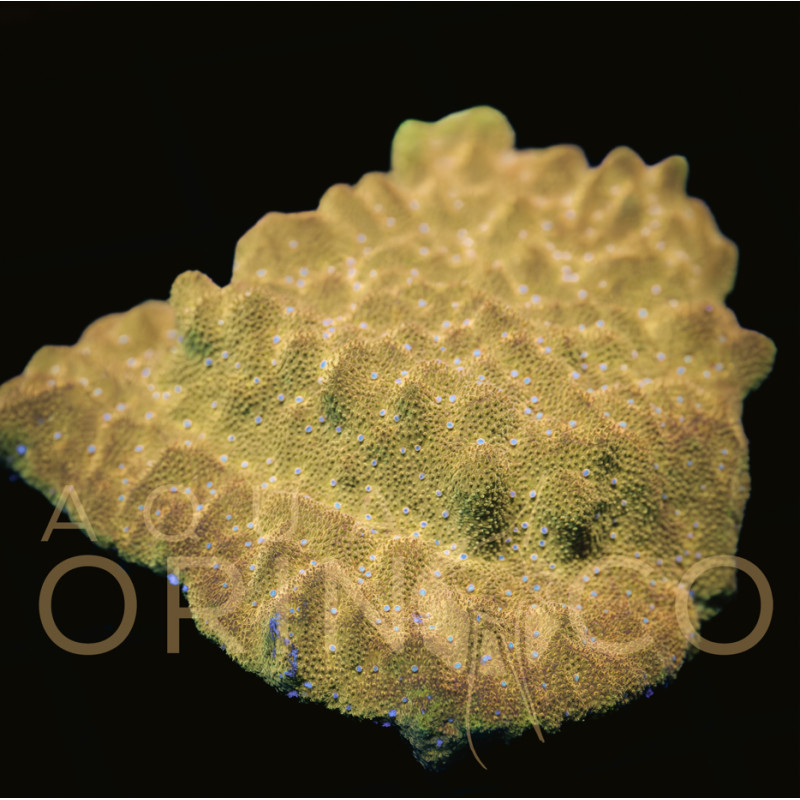More info
Psammocora sp. Watermelon
Unique piece - "WYSIWYG"!
What You See Is What You Get
The Psammocora Family
Psammocora is an uncommon stony coral in the aquarium trade. They are rarely imported compared to other corals and go unnoticed by most enthusiasts. Typically, I don't see many reef keepers striving to find this genus of corals.
It's a peculiar coral in the sense that most reef keepers, even those enthusiastic about SPS tanks, are not familiar with it. Its appearance, in many ways, resembles other encrusting small polyp stony corals such as Montipora, Leptastrea, Pavona, or Leptoseris. As they grow, the coral encrusts over the surface of the rock and can create a bright and beautiful landscape. Some varieties may form branches, but most of them are encrusting. There are structural variations from species to species within Psammocora, so it's understandable that enthusiasts and vendors misidentify this coral.
Location
Psammocora are found throughout reefs in the Indo-Pacific, including Fiji, Tonga, Solomon Islands, and the Great Barrier Reef in Australia.
Lighting
When it comes to lighting and placement in the tank, Psammocora are quite flexible. We have maintained Psammocora in different light intensities, but we prefer to keep them in aquariums with medium to high light. Anything around 100-200 PAR is a good starting point. Psammocora have consistent coloration, which means they won't completely change color in the same way Acropora or Montipora will, but that doesn't mean better lighting won't bring out more desirable coloration. In my tanks, at least, they seem to have brighter colors and better highlights when exposed to brighter light than in a weaker aquarium with less than 50 PAR.
One thing to always consider is not to expose corals to excessive light too quickly. Even if you plan to keep them under 200+ PAR lighting, it's always a good idea to acclimate them slowly to those intensities. Too intense lighting will kill a coral much faster than weak lighting, so when in doubt, opt for weaker light and slowly move the coral to brighter light. If you start to see Psammocora discoloring, the most likely cause is high light intensity, and I would recommend relocating the coral immediately or reducing the light intensity, if possible.

Low light |
Low light translates to about 30-50 PAR. |

Medium light |
Medium light is between 50 - 150 PAR per unit area |
|
High light |
High light is above 150 PAR per unit area |
Water Flow
Psammocora appreciate medium to high water flow. Water movement serves two main functions for corals. The first is that it carries away waste and helps prevent detritus from settling on the coral. The second function that strong water flow provides is transporting nutrients to the coral.
Feeding
Psammocora have small polyps, and you wouldn't expect to see dramatic feeding displays, but Psammocora are surprisingly good feeders. I say surprising because their polyps are very small, and most of the time corals with very small polyps tend to shy away from direct feeding. However, Psammocora can grab onto small food particles and quickly consume them. I wouldn't go out of my way to spot feed them, but they are more than capable of eating small pieces of mysis shrimp if given the opportunity.

Special Care
Psammocora is a diverse genus of small stony corals with small polyps (SPS). There is a wide variety of shapes and colors depending on where they were collected. Under proper conditions, they grow rapidly and exhibit wonderful coloration. They are much hardier corals than Acropora, as they don't bleach as quickly and are more resistant to coral diseases, yet maintain stunning colors that any Reef Aquarium deserves. Be cautious about the corals you place near Psammocora. They don't have potent nematocysts and will lose most territorial battles.
```





